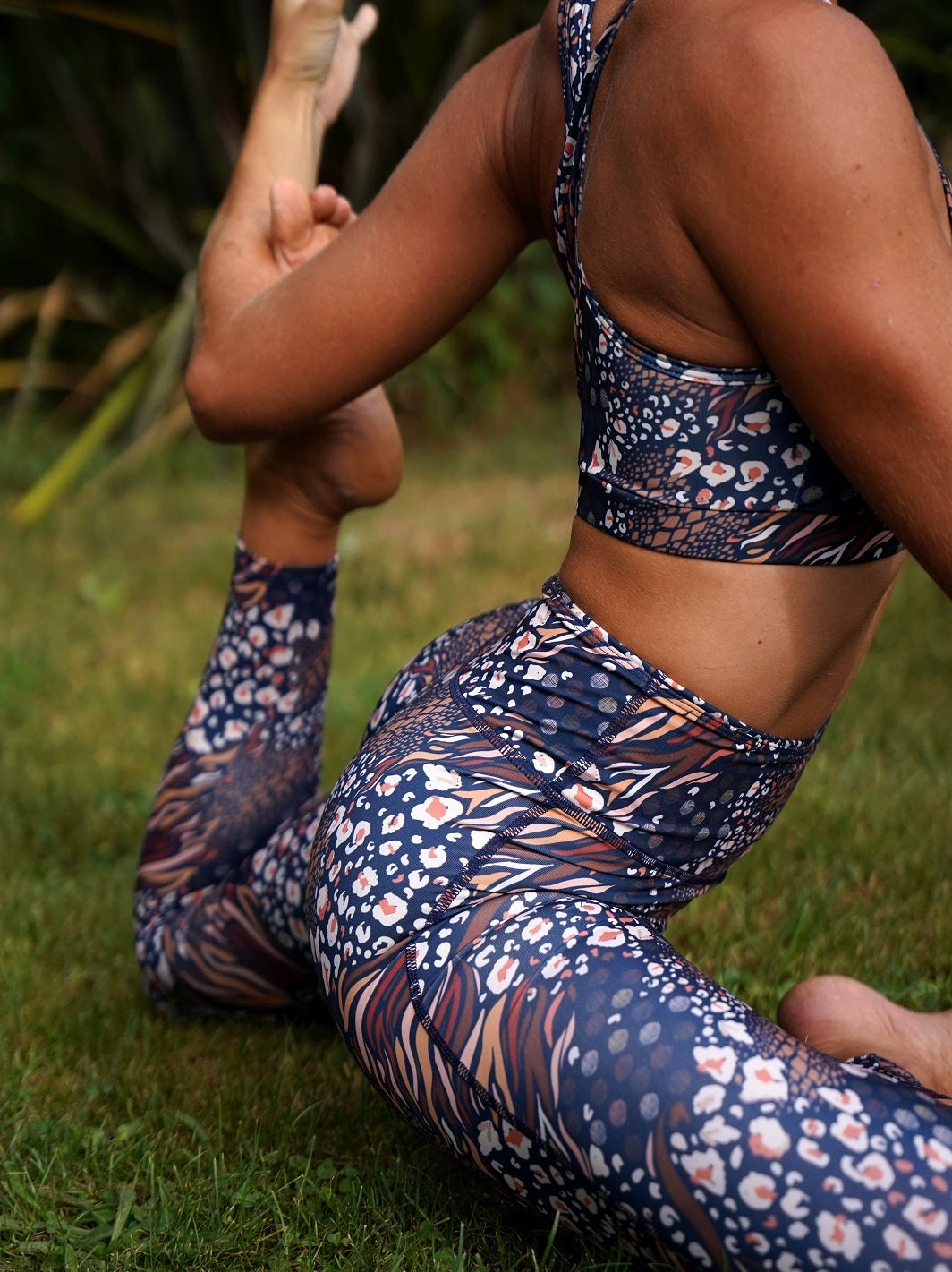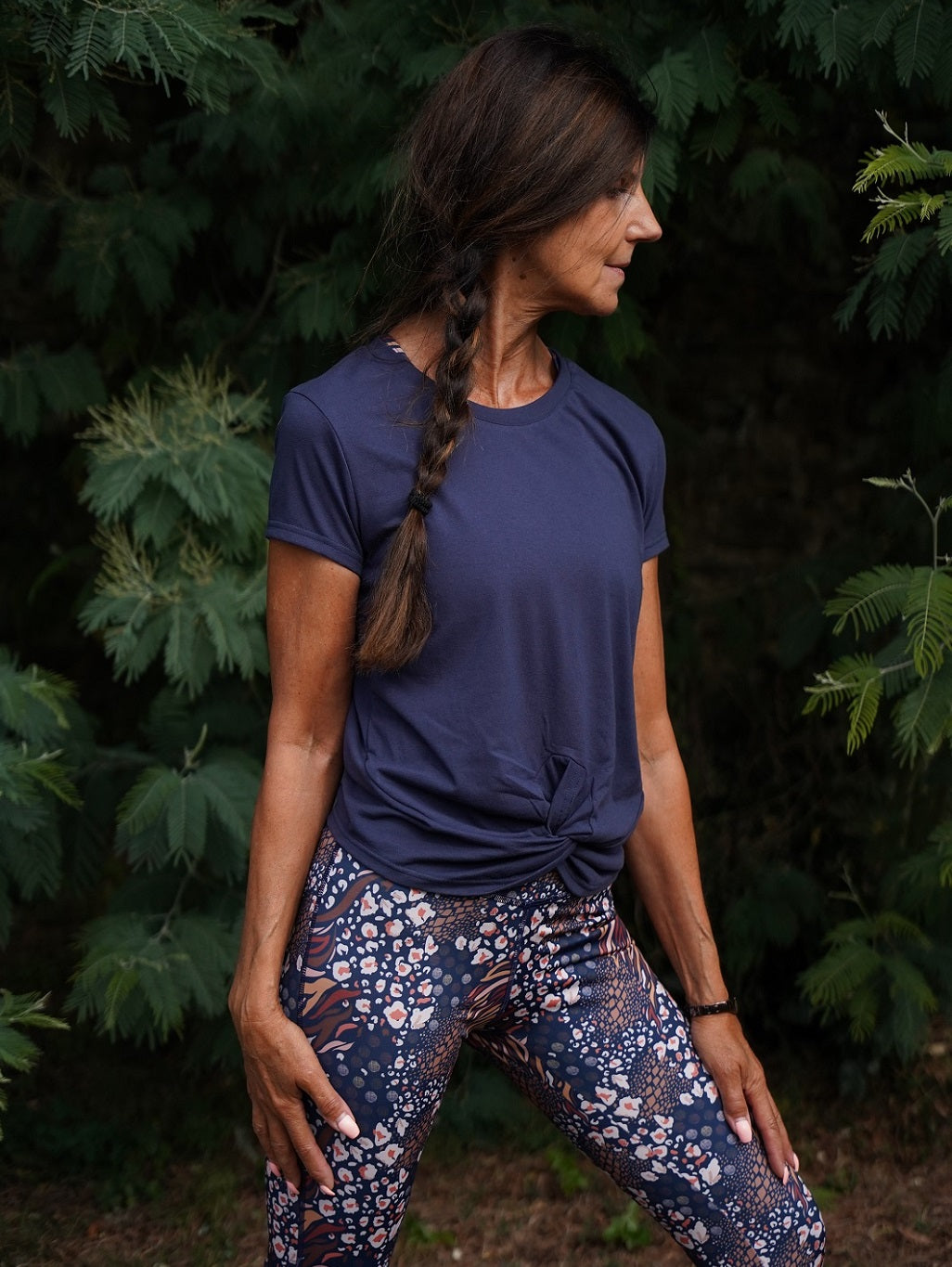[Part 2]
Let's tackle the remaining poses we discussed in our 19 most difficult yoga postures post.
If you missed the first part, here it is!
Without further ado, here is the rest:

9. Reflection with one foot behind the head or eka pada sirsasana
This posture is simply impressive!
Having a smile in eka pada sirsasana is probably a miracle...or many hours of training!
Step by step: From stick pose, raise your right leg, bend your knee and place it behind your head. The left leg is folded on the ground, the hands are in prayer.
How to prepare for it: a background as a dancer, natural flexibility or the patient work of many years of yoga are necessary to succeed in this posture!
Benefits: the thinking posture with one foot behind the head strengthens the back, neck and shoulders. It increases blood flow and circulation, especially to the back of the body.

10. The formidable face or ganda bherundasana
We reach the heights of yoga: this yoga posture is ranked 56 out of 60 on the Iyengar yoga difficulty scale.
Step by step: Starting from a position lying on your stomach with your chin on the floor and elbows bent, lift your legs and arch your back until your feet are resting on your head. If you can, stretch your legs towards the sky.
How to prepare for it: by starting to do yoga from a young age? by being a top athlete? I ask you 😉
Benefits: Great facial posture improves blood circulation, respiratory system and tones the abdominal organs.

11. Fetal (or embryo) posture or Garbhāsana
This yoga posture is most surprising but completely accessible to anyone who wants to take up the challenge.
Step by step: from lotus posture, bring the bent legs closer to the face, so that they are balanced on the gluteal muscles. Insert your arms into the free space between the thighs and calves by bending your elbows and bringing your hands towards your head. The hands can be in prayer, in meditation or placed flat on the head.
How to prepare: by working on the lotus posture, the basis of Garbhasana.
Benefits: Perfect back tonic, fetal posture also improves elimination and breathing.

12. The frog or Bekasana
Surprisingly, this posture perfectly imitates the famous batrachians, while energizing the legs!
Step by step: Lie on your stomach with your chin on the floor. Bend your knees back. Grasping your feet with your hands, press your heels toward the floor.
How to prepare: To feel comfortable in this posture, practice with prone floor postures like bow, sphinx, cobra. Go slowly to work on knee flexibility without injuring yourself.
Benefits: the frog pose offers an intense and tonic stretch that works the entire pelvis and the knee joints.

13. Lotus Leg Headstand Pose or Padma Sirsasana
This is a nice variation of the pose on the head, to go even further in the posture and work on both your balance and the flexibility of the pelvis.
Step by step: From headstand pose, bend one leg and place the foot in half lotus on the other leg. Stabilize the posture. Then bend the other leg and place the other foot on the groin crease.
How to prepare for it: to achieve head pose with lotus legs, you must of course first know how to master the head pose (see point number 1) as well as the lotus pose separately. Then it’s about putting the two together!
Benefits: intense stretching and strengthening of the entire body.

14. The Flying Warrior or Visvamitrasana
Also known as flying compass or side angle, is an advanced yoga posture in the practice of Ashtanga Yoga.
Step by step: From downward facing dog, raise your right leg. Bend your right knee and bring it forward, towards the elbow of your left arm. Grab the right foot with the left hand, bringing the right knee a little closer to the chest. With your left hand, grab the little toe of the right foot. Slowly begin to straighten your leg. Ultimately, we can no longer hold our ground!
How to prepare for it: by exploring all the slightly less arduous “sister” postures that allow you to lay a solid foundation: the triangle, the posture of the big toe held, the lying posture with your feet in hand, the plank on the side, the half-moon or the flight of the wise Kaundinya.
Benefits: the flying warrior pose offers an unparalleled opportunity to work on the flexibility of your legs and the openness of your shoulders.

15. The peacock or Mayurasana
The peacock yoga posture is one of the unfair postures because despite its apparent difficulty, some yogis will get there quite easily and others will take years to master it.
The outstretched legs levitating above the ground recall the long tail of the peacock, when it is not on a wheel.
Step by step: In a kneeling position, place your hands flat on the floor, facing outwards and pointing towards your knees. Bend your elbows to form a solid base. Lean forward and place your stomach on your elbows. Bring your head to the floor, then straighten your legs back. Take flight by lifting your legs, one after the other, contracting your abdominal muscles.
How to prepare for it: work on postures that deeply engage the wrists and shoulders to acquire the strength necessary to get into peacock pose, unless you get there naturally 😊
Benefits: the peacock pose undeniably develops strength, physical and mental, works the back muscles, glutes, quadriceps and even the calf muscles to fight against gravitational force.

16. Elephant trunk or eka hasta bhujasana
Simply stunning, the elephant trunk posture requires great strength in the arms.
Step by step: Starting in stick pose, with your hands on either side of your hips, bend your right knee and place it as high as possible on the outside of your right arm. Pressing on the hands, lift the pelvis and the left leg straight.
How to prepare: to have a good foundation before launching into the elephant trunk pose, practice the crow pose, the pendant pose as well as the boat.
Benefits: Eka hasta bhujasana in addition to strengthening the arms and torso, improves concentration and digestion. The posture energizes the body and mind while developing inner strength.

17. The legs behind the head posture or dwi pada sirsasana
Dwi pada sirsasana is one of those very impressive yoga postures where you should not skimp on the suppleness or flexibility of the body!
Step by step: Start by settling into stick pose. Bend your right knee and grab your right ankle. Gently bring it closer to your head to “tie” it behind your neck. Do the same with the other leg. This posture can be done seated but also in the lying position. A possible variation is to cross your ankles behind your head.
How to prepare: before you can put both feet behind your head, start by trying to put one in the posture of Reflection with one foot behind your head or eka pada sirsasana (see number 10). In general, work on hip opening and leg flexibility postures to best prepare for the posture of the legs behind the head.
Benefits: One of the number 1 benefits of dwi pada sirsasana is of course the incredible work on flexibility. The legs behind the head posture activates blood flow throughout the body, ideal for eliminating toxins. It activates the fire of digestion.

18. The fallen angel or Devaduuta Panna Asana
This is the more advanced variation of the twisting crow pose, itself a more advanced variation of the crow pose. As you can see, yoga postures come in multiple variations of twisting, balancing and back bending, to explore our body!
It is also a very aesthetic posture which will appeal to your qualities of grace and lightness as a dancer.
Step by step: place yourself in a squatting posture, balancing on your toes, your hands touch the ground with your fingertips on either side of your bent knees. Rotate with your torso to the right side, the left elbow is placed under the right knee. Lower your torso and bend your elbows to balance by placing both knees together on your left elbow, as in the twisting crow pose. Raise your left hip and foot.
How to prepare: Before launching into fallen angel pose, stretch your neck and wrists. Seated or lying twists, as well as different variations of the side plank are excellent preparation postures.
Benefits: The fallen angel pose improves blood circulation and body coordination. It strengthens the whole body and works on flexibility.

19. Double-Legged Inverted Stick Pose or DwiPada Viparita Dandasana
Probably the yoga pose with the longest name of all, which is a very, very advanced backbend with a beautiful chest opener! Compared to other postures on this list, it may seem easier, but don't let appearances fool you: this posture is and will remain very intense!
Step by step: While lying on your back, bend your knees and place your feet on the floor hip-width apart. Straighten your pelvis and bend your elbows, placing your hands flat behind your shoulders. Lift your shoulders and head off the ground, straighten your arms. Once in full wheel pose, slowly drop your forearms to the floor and interlace your fingers behind your head. Straighten both legs and lift your chest by pressing on the ground with your feet and with the base made of your hands.
How to prepare: to be able to perform the inverted stick pose with two legs, you must first know how to do the wheel pose with your arms outstretched.
Benefits: They are multiple, starting with the complete stretching of the body, the strengthening of the legs and the opening of the chest.
DISCOVER NOW!
Discover here our eco-responsible yoga outfits made in France from recycled materials, perfectly suited to practicing all types of yoga!
And so as not to miss any news from Géopélie, subscribe to our newsletter here at the bottom of the page 👇 we only send a maximum of two per month!





Leave a comment